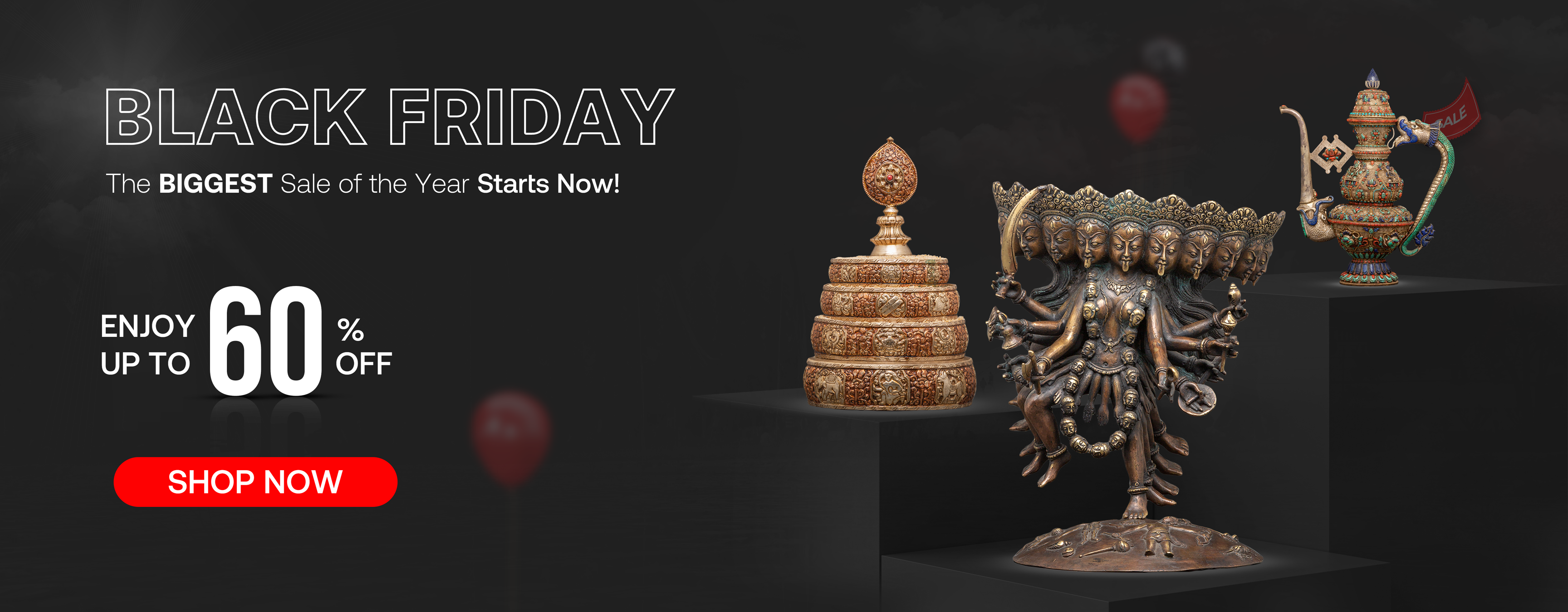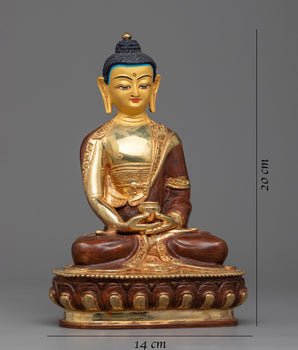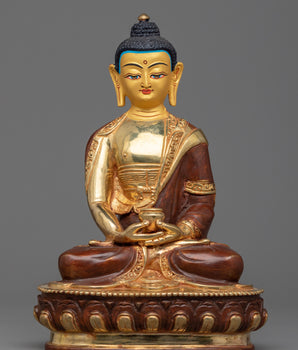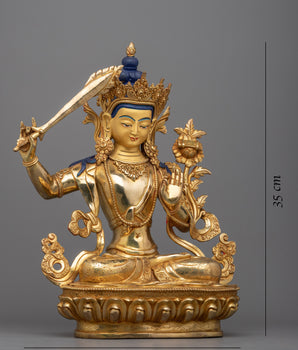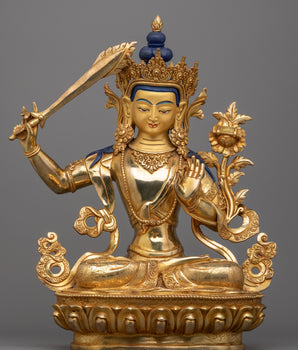The profound impact of sound in meditation, mantra recitation, and tantric rituals
In Vajrayana Buddhism, music is not just a form of artistic expression but a vital spiritual tool. It plays a central role in rituals and meditation, helping practitioners connect with the divine, purify the mind, and enhance their path to enlightenment. Vajrayana, also known as Tantric Buddhism, emphasizes direct, transformative experiences of the sacred through practices such as visualization, mantra recitation, and ritual. Music and sound in this tradition are more than mere accompaniment; they are considered essential instruments for spiritual awakening and transcendence.
Here’s why music holds such significance in Vajrayana Buddhism.

1. Music as a Path to Transcendence
In Vajrayana Buddhism, sound is used as a tool to move beyond ordinary perception and attain higher states of consciousness. Instruments such as the Kangling (bone trumpet), Tingsha bells, and Dungchen (longhorn trumpet) are more than just ritualistic tools—they help clear the mind, enabling practitioners to focus on the sacred.
-
Transformative Sound: The sounds produced by these instruments help break mental distractions and shift awareness toward the divine. The sound vibrations are believed to help the practitioner connect with deeper spiritual realms, moving beyond mundane experiences. Source: Journal of Buddhist Studies suggests that sound is a catalyst for spiritual transformation, helping practitioners clear the mind and focus on the sacred.
-
Wisdom and Compassion through Sound: The harmonious sound of these instruments reflects the spiritual ideal of balance, helping practitioners align their own wisdom and compassion as they move toward enlightenment.
-
Summoning Spiritual Forces: The sound of the conch and other sacred instruments invites divine blessings and purifies the ritual space. These instruments create an environment conducive to the arrival of spiritual forces, facilitating the practitioner’s connection with the divine.
- Music as a Reminder of Impermanence: These instruments remind practitioners of the impermanent nature of existence, helping them face death and impermanence directly and, ultimately, leading them to spiritual transcendence.
2. Mantras and the Power of Sacred Sound
A central aspect of Vajrayana practice is the use of mantras, which are sacred syllables or phrases believed to have transformative power. When recited or chanted, mantras produce sound vibrations that align the practitioner’s consciousness with universal truths. Music and sound enhance the potency of these mantras during meditation and rituals.
-
Vibrational Power: The vibrations created by mantras, amplified by musical instruments, purify the mind and facilitate spiritual transformation. The sound not only aids in focusing the mind but also helps in overcoming negative influences.
3. Purification and Protection through Ritual Sound
Sound is also integral to the purification and protection rituals in Vajrayana Buddhism. Instruments like the Tsingsha cymbals and Dungchen trumpet are used to cleanse the environment of negative energies and protect the space during rituals.
-
Creating Sacred Space: These sounds are believed to purify the surroundings, dispelling obstacles and negative forces. By creating a sacred sonic environment, they open the space for spiritual transformation and divine presence.
Exploring the Sacred Musical Instruments Used by Tibetan Monks in Rituals
Tibetan Buddhist rituals are rich in symbolism and deeply connected to spiritual practices. One of the most important aspects of these rituals is the use of unique musical instruments that play a key role in invoking divine blessings, warding off negative energies, and focusing the mind during meditation and prayer. These instruments are not just for musical accompaniment but are integral to the success of Tibetan Buddhist ceremonies. Let’s explore the various sacred instruments used by Tibetan monks and their deep symbolism.
1. Kangling: The Trumpet of Human Bones
The Kangling is one of the most unique and powerful instruments used in Tibetan rituals. Made from a human femur (originally) or other bones, the Kangling is a trumpet-like instrument that creates a deep, haunting sound. It’s often used in esoteric practices, especially in Vajrayana Buddhism, where it plays a crucial role in cutting through the illusion of life and death.
-
Symbolism: The sound of the Kangling is meant to remind practitioners of the impermanence of life and the transitory nature of all things. It is believed to help dispel negative spirits and energies, marking a conquest over death and illusion.

2. Conch Shell (Shankha): The Call of the Dharma
The Conch Shell, also known as Shankha, is a revered instrument in Tibetan Buddhist ceremonies. When blown, the conch produces a resonant sound that symbolizes the spreading of the Buddha’s teachings (the Dharma) to the world.
-
Symbolism: The sound of the conch shell is associated with the voice of the Buddha and represents the call to awaken spiritual consciousness. It is used to purify the environment, invite blessings, and drive away negative forces.

Click here to read our Blog about Conch Shell
3. Bells: Symbolizing Wisdom and Compassion
Vajrayana Buddhism, the bell (ghanta) is one of the most important ritual implements, always used in conjunction with the vajra (dorje). Together, they symbolize the inseparability of wisdom (prajñā) and skillful means (upāya) — the union that leads to enlightenment.
4. Tsingsha: Small Cymbals with a Big Impact
The Tsingsha are small cymbals made of metal, producing a bright, resonant sound when struck together. They are often used in larger ceremonies and prayers to keep rhythm and focus.
-
Symbolism: Tsingsha represents the pervasive nature of Buddha’s teachings. They are used to purify the environment, create harmony, and eliminate negative energies during rituals.
5. Dungchen: The Majestic Longhorn Trumpet
The Dungchen, a long, metal or wood-made trumpet, is used in large ceremonies and rituals. With its deep, resonant tones, it is often likened to a low, sacred hum. This instrument is a powerful symbol of spiritual sound and is used to invoke divine blessings and mark the sacred moments in Tibetan Buddhist ceremonies.
-
Symbolism: The Dungchen is a symbol of the sound of the Dharma and the presence of spiritual wisdom. Its resonant tones invite divine forces, strengthen the power of the ritual, and signify the opening of spiritual realms.
6. Damaru: The Hand-held Drum of Creation and Destruction
The Damaru is a small, hand-held drum used in tantric rituals. Made of two hemispherical parts, the drum is shaken to create a distinctive sound. The Damaru is most commonly associated with deity worship and the symbolic dance of creation and destruction.
-
Symbolism: The Damaru represents the balance of creation and destruction, a fundamental concept in Buddhist teachings. Its rhythmic sound aids in focusing the mind, helping practitioners align with the natural rhythm of the universe.

7. Bongo Drum: Connecting to Cosmic Rhythms
The Bongo Drum or large hand drum is an integral part of Tibetan rituals. Its deep, resonant tone adds rhythmic structure to prayers, chants, and ceremonies. The Bongo is used alongside other instruments to create a deep connection to the spiritual realms.
-
Symbolism: The Bongo drum symbolizes the cosmic rhythm that connects the practitioner to the universe. Its deep sounds align the practitioner with the universe's natural rhythms, allowing for greater spiritual focus.
8. Chung: Cymbals for Purification and Harmony
The Chung are small cymbals often used in Tibetan Buddhist rituals. They are typically struck together to produce a resonant sound that enhances the chanting of monks and helps maintain rhythm throughout the ceremony.
-
Symbolism: The Chung cymbals symbolize the resonance of the Buddha’s voice, purifying the environment and assisting in the manifestation of spiritual wisdom. The sound invites peace and harmony, allowing practitioners to focus on their spiritual path.

Conclusion: The Sacred Soundscape of Tibetan Rituals
Tibetan monks use a variety of musical instruments in their rituals, each serving a distinct purpose and carrying deep spiritual symbolism. From the haunting sound of the Kangling to the resonant tones of the Dungchen, every instrument plays a pivotal role in enhancing the effectiveness of Buddhist ceremonies. These instruments are not only tools for making sound but are seen as sacred instruments that help connect practitioners with the divine, spread the teachings of the Buddha, and create a harmonious spiritual atmosphere.
Whether it’s through the Tingsha’s clear ring or the Damaru's rhythmic beats, these instruments shape the spiritual experience, guiding practitioners toward greater wisdom, compassion, and enlightenment. The sounds of Tibetan Buddhism resonate far beyond the monasteries and temples, serving as a reminder of the interconnectedness of life and the sacred nature of all existence.
Also Read our Blog: Harmonizing Spirit and Sound: Exploring the Art of the Tibetan Chod Drum







